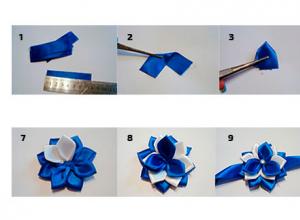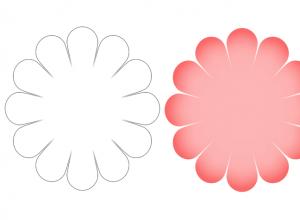Full length human figure. Human figure proportions
Drawing still lifes and landscapes is, of course, great. But in the creative life of any artist there comes a moment when interest in a person awakens in the soul. He takes up a pencil or brush, runs to the canvas and... Realizes that he doesn’t know where to start.
We see people around us every day, we see our reflection in the mirror, but for some reason it is the image of the human body that is given to the masters of fine art with such difficulty. But in order to correctly depict human figures, you need to know the proportions of a person for. It is with the study of the basics of plastic anatomy, the relationship of individual parts of the body with each other, that the creative path of any creator of art begins.

Dot, dot, cucumber...
Contrary to the well-known children's rhyme, a person does not consist only of dots and sticks. Our outer shell is multifaceted and beautiful, special and at the same time has common features inherent in each individual. So let's look at the fundamental points regarding the proportions of the human body, which are so necessary for drawing.
To date, about a dozen different methods and approaches have been developed to determine the “ideal human figure.” They all have the right to exist, because people are not copies of each other, but individual individuals. But we will look at the most popular methods for calculating human proportions for drawing, which are suitable for beginners.
It is worth remembering that the human body is divided into eight parts:
- Head (from crown to chin).
- Upper chest (chin to nipples).
- Lower chest (from nipples to navel).
- Pelvis (from the navel to the perineum).
- Upper leg (mid-thigh).
- Lower leg (to the knee).
- Calf muscles.
- Shin and foot.
Thanks to this division, it is much easier for the artist to draw proportional people. Reference points and landmarks appear that help the pencil move in the right direction.


Uncle Styopa and Dwarf Nose: where to find the “golden mean”?
The first thing that catches your eye when looking at a person is his height. The reference unit of its measurement in fine art was the head. To date, several standards for this approach have been developed.
The first one is normal. This type of proportion is used in academic painting. Holds 7 “heads”. The second, not far removed from it, is the idealistic standard. Consists of 8 “heads”. It is used in practice by the vast majority of contemporary artists. This is what we will call “golden”. Using this approach, it is quite easy to divide the human body into the eight equal parts we discussed above.
The next two types are also quite interesting - model and heroic. The first consists of 8 and a half “heads”, and the second of 9. The people depicted with their help really look like catwalk models or mythical heroes with gigantic growth. Take a closer look at each of the methods and experiment with them. The appearance of the resulting people will be noticeably different from each other. This will help you master this skill and understand which method is right for you.

Let's start drawing!
We will analyze the remaining proportional relationships along the way. So, mark on the sheet the places where the top and heels of the future person will be located. Draw a vertical line between the points and divide it into 8 equal parts. In this case, the first line should be at the level of the chin, and the last line should be at the stop. The height of each part, as we remember, is the head.
The distance between the most distant points (shoulders) is equal to the height of 2.3 heads. With a vertical line already drawn, we divide it in half. You also need to remember the following key points:
- the width of the waist is equal to the whole head, while in men it is lower than in women;
- the elbows are located at the level of the navel, and the fingers reach the middle of the thigh;
- hips narrower than shoulders;
- the torso of women has rounded outlines, while men are trapezoidal and angular;
- the arm from the elbow to the tip of the finger is equal in length to the leg from the knee to the heel;
- the neck is not a cylinder, and therefore tapers downward, and the transition from it to the shoulders should be trapezoidal;
- Don't forget about the natural curves of your body!
To understand this last point well, you need to spend a little time studying the muscle groups of the human body. Thanks to them, we do not look like smooth geometric shapes, but have smooth and beautiful outlines. To calculate the length of the feet and palms for drawing, the proportions of the human head are also used. The sole of a man's foot and palm occupy the largest part of it, while that of a woman takes up correspondingly less.
Measuring the proportions of a person's face for drawing is done using the length of the index finger. This is what corresponds to the height of the ear, the distance between the pupils, from the inner corner of one eye to the outer edge of the other, from the chin to the tip of the nose, from the eyebrows to the hairline. Of course, it is difficult to contain all the nuances of drawing the human figure in one article. Besides, a lot comes with experience, so go for it. Don’t be afraid to try and make mistakes, the main thing is desire, and then you will definitely succeed!
The history of the development of fine arts and architecture knows many rules and canons of the size of the human body. Of all those proposed by history, the most convincing, simple and correct measure for measuring the human body is the head. As a guide, we provide only basic information about the dimensions of the human body and its parts.
When relating the head to the figure and its parts, the following measures are used:
- head height;
- height of head and neck;
- head diagonal;
- length and width of the brush.
In Fig. 25, the figure of a man with arms outstretched to the sides is inscribed in a square. In this case, the head, arms, and legs touch the sides of the square. This means that a person's height corresponds to the distance of his arm span.
The same figure shows the proportions of the human body with age characteristics. In children, the head is much larger in relation to the body than in adults. Moreover, the torso in children is longer than the upper and lower limbs. In a newborn, the head fits the length of the body three and a half to four times, in a three-year-old child - 4.5-5 times, in a seven-year-old - 6 times. At fourteen years old - 7 times. As for the proportion of a child’s head, the ratio of the facial part to the cranial part, in contrast to the head of an adult, will be: for a child under one year old - 4 times; up to two years - 3.5 times. As the child grows, the body proportions take on the position of an adult.
Human growth is divided into two equal parts. The point of dividing growth in half is the pubic articulation of the pelvis or the point of intersection of the diagonals of the square and the center of the circles inscribed in the square (Fig. 25, 26).
The chest is one of the main formative parts of the human body; its height is determined by the size of the head with the neck and humerus. It resembles an inverted ovoid shape, where the lower base is wider than the upper with a ratio of 1:2, or its lower base is equal to the diagonal size of the head. When viewed from the side, the shape of the chest is flattened in volume relative to the front view in a ratio of 1:1.5. The distance between the nipples of the breast is equal to the height of the facial part of the head (from the base of the tip of the chin to the frontal tubercles) or the length of the hands. The width of the shoulders corresponds to two heights of the head. Between the jugular notch and the navel, approximately in the middle, is the lower base of the pectoral muscles. The distance from the navel to the pubic joint corresponds to the height of the front of the head or the length of the hand.
The shape of the pelvis is the second component in the lower torso region. It has the following characteristics: the upper base is equal to the diagonal size of the head; the lower base is the width of the head; the height of the pelvis is the height of the head. The female pelvis is wider and lower and has an enlarged pubic opening, unlike the male one. The distance between the bases of the chest and pelvis is approximately half the height of the head.
The width of the hip joint in relation to the width of the shoulder in men is 1:1.8; for women - 1:1.
The length of the arm corresponds to three heights of the head. In this case, the ends of the middle finger, with the hand lowered, reach the middle of the thigh. The shoulder, if we mean the distance from the humeral process of the scapula to the elbow, is one and a half times the height of the head.
The forearm, foot and diagonal of the head have the same dimensions (Fig. 26, 27). The length of the hand, the height of the front part of the head, the length of the sternum, the distance from the pubis to the navel and the length of part of the forearm with the arm bent in front (to the bend of the front edge of the shoulder) have the same values. The length of the hand is divided in half by the distal ends of the metacarpal bones (at the level of the bend). The length of the phalanges of the fingers from the first to the fifth is measured according to the level of bend of the interphalangeal joints. Thus, the lengths of the proximal phalanges and the combined lengths of the middle and distal phalanges of the second and fifth fingers are equal.
At the level of the middle of the proximal phalanges there are interphalangeal connections called membranes. As for the thumb, its metacarpal bone is smaller in relation to the two parts of the phalanx and is approximately 1:1.8. The length of the proximal and distal phalanges of the thumb with the hand straightened almost reaches the bend of the index finger.
The dimensions of the thigh are equal to the length of the lower leg, including the height of the foot, and correspond to two dimensions of the height of the head. In Fig. Figure 27 shows the dimensions of the head and neck, shoulder, forearm, hand and foot and their relationships with each other. The length of the thigh is equal to the distance from the nipples to the pubic joint, the protruding bone of the thigh - the greater trochanter - is located at the level of the pubic tubercle.
This information about the proportions of the human body has average proportional values; a proportionally built man of about 30 years old with a height of 172-175 cm is taken as the basis for measurement and study. These data can help to find individual and characteristic features in each person when drawing his head and figure.
Who doesn’t remember the famous work of Leonardo da Vinci, where the artistic diagram clearly illustrates the proportionality of the human body. Harmoniously designed, it looks incredibly beautiful. But we ourselves need to figure out how to draw a person. It is worth learning to convey this harmony of proportions of the human body. How? Now I will try to show what discoveries I have made for myself in drawing the human figure.
I will be helped by some kind of guide on how to draw the human body, a set for creativity from the items necessary for every artist, both a professional and a beginner, for example, a preschooler: paper, pencils, a ruler and an eraser. My son, who is 7 years old, will also come to my rescue.. My baby and I decided that our model of a person was a man in jeans and a T-shirt. We found his photograph on one of the websites.
But I would like to note right away that this step-by-step instruction assumes that those who follow these drawing lessons will be able to easily repeat any step. And it won’t be difficult even for a child to do this..
We distribute the entire execution of a person’s drawing into several stages:
- Support work;
- Picture detail;
- We “revive” the drawing of a human figure.
Support work
First of all, we make a schematic sketch, taking into account the proportions of the person.
How to draw sketches of people correctly? To do this you need to start small. We make an image of an oval. This will be the head. We measure its size. I got it to be 2 cm long. The proportions of a person are such that you need to measure only 7 of these lengths to depict a person of average height.

Here's a sketch of the silhouette. It’s difficult to see a picture of a person in this. But this is how we will understand how to draw a full-length person.

Now we are waiting for exclusively step-by-step work.
Neck.
A person's neck can be different. But I went by the average. The neck is usually no wider than the head, and at the same time not too thin, about half the width of the head.Do not forget that this is a pencil drawing for beginners and there may be some inaccuracies in it. With practice, you can achieve good success and even understand how to teach a child to draw a person, no matter how old he is.

Shoulders.
To draw the shoulder line, it is important to take into account the fact that on average a man has them the same length as his head. And one moment. Draw the shoulders with a slight downward slope (see picture above).Waist.
How to draw a human figure? The next point is how to “find” and draw our person’s waist. Marking will help with this. If my head is 2 cm, then I will define my waist below the fifth cm, approximately 5.2-5.3. I put a point and from it I draw a horizontal line, which will be greater than the width of the head, but less than the span of the shoulders. I connect this line with the shoulder line.
Torso.
The fourth mark (from top to bottom) will be the point of the lower torso. It is usually wider than the waist, but should not be wider than the shoulders. Draw a horizontal line. We connect its edges with the waist.
Legs.
The drawing of a person should be complemented by the “making” of the legs. How easy is it to do this? Let's divide this stage into several steps:
Hands.
We are approaching the final stage and complementing the drawing of a person with another important detail - the hands. And again we divide this step of drawing a person with a pencil step by step: In general, we figured out how to draw a figure. But that is not all. Now the model needs some details to be worked out.
In general, we figured out how to draw a figure. But that is not all. Now the model needs some details to be worked out. Picture detail
Our pencil-drawn person needs a face to “appear.” And that’s why we depict each element in the picture. And these are ears, hairstyle, eyes, nose and eyebrows.
We were able to draw a human figure. But this was just a diagram. Now we work on each detail of his clothing separately. We make folds on the clothes, and even mark some noticeable seams.

Erase all auxiliary lines. And now we see that this is more reminiscent of a human appearance than the picture of a robot “on hinges” was until now.

Let's bring our model to life
We figured out how to draw the body. And now we will dress this body. In the photo that we chose as a model, there is a man in jeans and a T-shirt. We show all this in our image.
Don’t forget about the chiaroscuro effect, as this makes the work more voluminous.

If until now it was difficult to explain some points to children, then even a child who is one or two years old can cope with the coloring stage.

The child and I tried our best and we ended up with a pretty handsome man. Perhaps in the future we will be able to learn to portray a girl and a child. The main thing is the beginning. Good luck in your future practice!
See below for a few more options.
Proportions of the human figure have interested artists, philosophers and educators over the past 20 centuries and more. The Roman architect Vitruvius wrote at the beginning of the 1st century AD: “Nature has shaped the human figure so well that the face, from the chin to the roots of the hair, is a tenth of the whole body.” He also argued that the navel is the center of the body, so a circle drawn around this point would touch the outstretched fingers and toes of a person lying on his back. It was this theory that was illustrated in famous drawing by Leonardo da Vinci presented below.
Unfortunately, theory only works in practice if the hands are at a very specific angle. However, you can notice that when the arms are extended to the sides, the distance between the tips of the fingers is approximately the same as between the top of the head and the soles of the feet. This useful rule when determining arm length.
During the Renaissance, human anatomy became the subject of detailed study, and artists began to participate in the search for meaningful mathematical relationships between the sizes of different parts of the body. Comprehensive approaches have been invented to determine " perfect figure". Since then, hundreds of such approaches have been developed using various parts of the body as units of measurement, including the head, face, legs, forearms, index finger, nose, spine, and so on. But, since no one approach was universal, because There is no denying the obvious fact that all people are different, these approaches are of interest only to the classics. Accepted ideal figure proportions Also are changing from one generation to another. Therefore we must in general observe a wide range of sizes and shapes of people that we see around us.

For our purposes, however, useful to study an average-sized figure, as this gives us a base on which to build proportions.
The most common method- using head height as a unit of measurement for relative measurements of different parts of the body. The average figure is seven goals, but a range between six and eight heads is also considered normal. In fact, most often in drawing tutorials the "ideal" figure is depicted eight heads tall- mostly, I suspect, because the body can then be divided vertically into eight convenient sections: chin, nipples, navel, crotch, mid-thigh, knees, calves and feet, making life easier for the instructor!


However, rules are made to be broken! We can admire the remarkable achievements of Roman architects and Renaissance artists/mathematicians, all of which should offer us a convenient test of proportions, but it would be foolish to limit ourselves to just this method.
Children's proportions
When drawing children, you will find that the head occupies a much larger proportion of the total height. The head of a newborn baby is about a quarter of the total height, and the length of the legs is much less. But as the child grows, the legs increase in length much more than other parts of the body in relation to the overall height of the body, so that the head becomes proportionately smaller.

Distribution of subcutaneous fat
During childhood, male and female body shapes are very similar. The average adult male's body shape is primarily dictated by the size of his muscle mass, while the average woman's body shape is determined primarily by the size of her fat mass. When girls reach puberty, there is an increase in fat deposits in very specific places to give the roundness of the breasts and hips of an adult woman.

Below are illustrations of where it is deposited. subcutaneous fat in women and men. Both sexes have reserves high on the back between the shoulder blades, which show up in obese people of both sexes with hunched shoulders and a short neck. However, other places where fat accumulates are different between the sexes. A man's excess weight is more characteristic of his waist than his hips. Excess fat in men stored above the hip bone at the back on either side of the spine and on the upper abdomen. Overweight women, on the contrary, tend to gain more on the hips than on the waist. Their main fat storage areas are the lower abdomen, buttocks and thighs, as well as the chest and back between the shoulder blades, just like men.
 Fat distribution in women
Fat distribution in women 
Proportions of elderly people
In old age flexor muscles, usually, are being reduced, become shorter. This makes the body bent, when it is in a normal standing position. The shoulders are rounded, the natural curve of the thoracic spine increases, and the neck pushes the face forward. Even when the body is relaxed, the arms and legs remain slightly bent.
The skin and subcutaneous fat become thinner and the muscles contract. Elbows and wrists appear larger, and veins may become visible and protrude from the skin. All fat deposits on the body and face become softer and tend to sag at the elbows and under the chin.

From the next lesson we move on to practice of drawing a person.
I hope you enjoyed this tutorial! Leave your comments and remarks about the course.
The article used materials from the books:
— Ron Tiner “Figure Drawing without a model”;
— Loomis E. Nude. Drawing Guide.
However, given the number of existing methods for measuring proportions (canons), we must understand how differently proportions can be interpreted, and that perhaps none of these methods is completely accurate.
What are proportions?
Proportions- This is the relationship between the width, height and depth of an object.
To draw a believable image of anything, no matter what or who it is, we need to convey the proportions of that object as accurately as possible.
For example, in the picture on the right, the width and height of the rim of the mug are approximately equal, while the depth of the mug is approximately one and a half times the width. These proportions are typical for this mug, in this particular situation.
What happens if I change the proportions? The mug I draw won't look exactly like the mug in front of me, but it will still be fairly recognizable.
However, if we need to draw a human figure or a portrait, accidentally changing the proportions can lead to noticeable distortions that make the drawing appear implausible.
Small errors in body proportions will only reduce the resemblance to a specific person, while large errors can seriously distort the anatomical structure.
It is not at all surprising that artists at all times have tried to develop a single standard for measuring proportions!
How convenient it would be to just memorize such a system and rely on it for everything... but can we really rely on any of these systems, regardless of who we are drawing?
To find out the answer to this question, let's look at a brief history of the canons of proportions.
A Brief History of the Canons
Each canon (a system for measuring proportions) was born in the search for a certain ideal of beauty. Since the concept of beauty is very subjective and changeable, the canons have been the same throughout history.
For example, the famous ancient Greek canon created by Polycletus creates the image of a strong, courageous athlete who achieved success in gymnastics and is excellent at wielding weapons.
A typical example of work in this canon is the statue of Doryphoros, one of the most famous statues of the era of Classical Greece.
Nowadays, you rarely meet people whose body fully corresponds to modern “ideals” of beauty, and probably in the time of Polykleitos, few could boast of such an “ideal” body as Doryphoros.

In addition, the canons were used to establish units of measurement, with the help of which it was convenient to divide the body into parts, which were then compiled into “ideal” proportions. For example, in the oldest system of proportions, the ancient Egyptian canon, such a unit of measurement was the length of the middle finger. It was believed that it was equal to 1/19 of the length of the entire body.

In the ancient Greek canon of Polykleitos, the palm was chosen as the unit of measurement.
The ancient Roman architect and writer Marcus Vitruvius believed that the height of the head was 1/8 of the total height of a person.
Leonardo Da Vinci demonstrated many of Vitruvius's ideas with the famous image of the "Vitruvian Man", which depicts a man in two superimposed poses, inscribed in both a circle and a square.
Canons of proportions today
As you might have guessed, searching for perfect methods for measuring proportions is a pointless exercise. Human bodies are so different that they will never all fit into one standard. The uniqueness of each of them is the most complex and fascinating part of depicting a figure. Nevertheless:
Knowing a few of the most basic proportions will greatly help us in drawing if we apply this knowledge in combination with a careful study of the body of a particular model.
Today the most common unit of measurement is the head. It is believed that the total body length averages 7.5 - 8 heads.
What is the difference between figures with a height of 7.5 and 8 heads?
An 8 heads tall figure will have very long legs like top models, while a 7.5 heads tall figure looks more average. Please note that these generalizations should not be considered a rule either.
Seven proportions of the human body
Before diving in, please remember that these proportions are for a standing figure. If the figure is tilted, sitting or lying down, measuring the proportions will be much more difficult and may not match the proportions shown below.
Here are seven proportions of a standing figure that are useful to remember:







System of proportions of the human figure: pros and cons
- the proportion system gives you basic guidelines for determining the correct distances
- proportions help create a more accurate drawing when compared to the proportions of a specific model
- remembering proportions will provide indispensable help in drawing from memory or “from the head”
- remembering the proportions will help you give free rein to your imagination, for example, an animator may decide to lengthen or shorten a figure by one or two heads if he is drawing a fictional character
Against:
- Relying too much on memorized proportions can cause you to be too lazy to look at the model and your drawings to become lifeless
- Due to the huge variety of figures and body types, no one system of proportions can be considered an immutable rule
Using proportions effectively
A proportion system can make your drawings more universal or more specific, depending on how you use it. How, knowing the proportions, can you achieve greater accuracy in your drawing?
Don't expect the model to exactly match the proportions shown above, instead use them to find the differences. For example, you know that the navel is usually three heads below the top of the head. Measure and find out if this rule applies to your model.
If not, then in the process of measuring, you will be able to determine at what height the navel is located in the person you are drawing.
Knowing the proportions will help you develop that special sense that allows you to calculate the correct distance by eye, even if the model’s proportions are far from classical.
Latest site materials
Horoscope

Burdock oil for dandruff
Every healthy person undergoes renewal of the stratum corneum of the skin once a month. However, for a number of reasons this process may accelerate. That's when dandruff appears. Seborrhea, or dandruff, is a process in which exfoliated skin particles on the surface
Cosmetology

Lush, fluffy DIY ribbon bows
Bow - he is always with us in life. When discharged from the maternity hospital, the baby is tied with a ribbon with a beautiful bow. As time goes by, bows decorate the clothes and head of the now grown-up princess. Mom has to master the art of making hairpins, ties, gift
Cosmetology

Massage technique for bust enlargement What massage should be done for breast growth
Every girl wants to have beautiful, large and firm breasts. Before running to a plastic surgeon, consider a bust enlargement massage, which will help solve the problem not only with size, but also with shape. It can be done in a salon or at home with a mini
Health

Templates for cutting out paper flowers to print
Every woman dreams of being surrounded by beautiful flowers. In order for them to always be with you, you can create various flower arrangements directly on the walls of the room. All kinds of flower stencils can be made with your own hands or purchased at a store
Experience

Copybooks for children 5 6 years old letters
The ability to write is one of the most important skills, along with reading, that any person should master (see also:). Many parents unreasonably believe that they need to start teaching their child as early as possible, that this skill is the highest indicator.
Experience

The best men's hobbies according to HG
Unusual hobbies are more common for men than for women. If you familiarize yourself with materials about people’s non-standard hobbies, you will notice that the main part of the heroes are representatives of the stronger sex. Perhaps ladies are less likely to strive